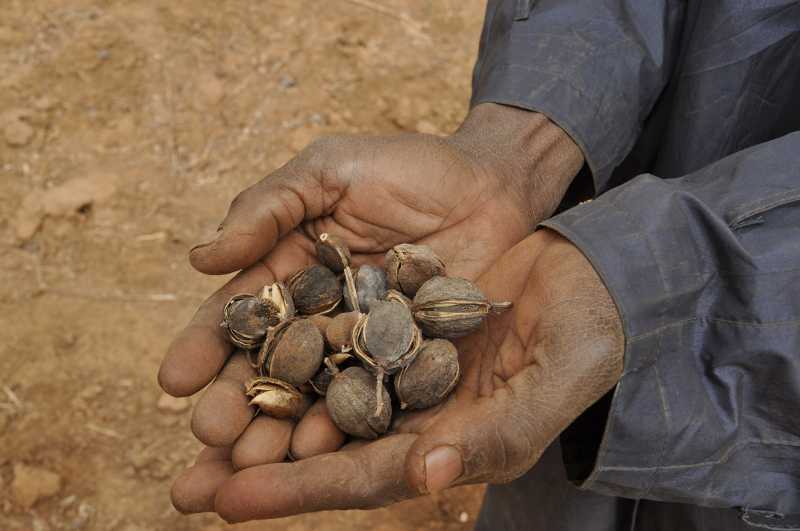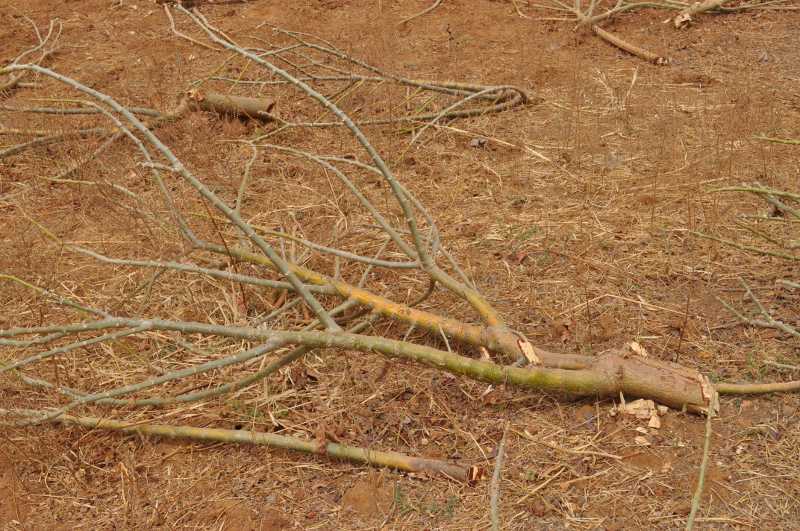Straight from the farmers’ mouth: “There is no profit in this”
Passing by the town of Boni on February 8th after having learnt that the Agritech company had started buying Jatropha* grains, I stopped to find out more. I felt quite sure that it would be difficult to find any enthusiasm among the farmers. But what I now came to see went beyond the limits of my imagination.

 start out a farmer directed me to the road to Bansié, a village north of Boni. And there, before me, was a scene of desolation: a field burnt to ashes (see picture). The discontent with the Agritech firm was such that one of its Jatropha plantations had been set on fire.
start out a farmer directed me to the road to Bansié, a village north of Boni. And there, before me, was a scene of desolation: a field burnt to ashes (see picture). The discontent with the Agritech firm was such that one of its Jatropha plantations had been set on fire.
Among the discontented there were both Agritech employees , complaining that they had not been paid for months (they finally received their pay some time between the 9th and the 11th of February, after my visit), and farmers who felt that they had been deceived. They had been led to believe that the cultivation of Jatropha was going to be profitable for them. Not at all! They now feel that they have been trapped and that they are the victims of a massive swindle.
What lay before my eyes had all the appearance of proving their case..

 A farmer guided me to his field, a beautiful piece of land with mango trees and some market gardens. Behind the mango grove there was a large former maize field. The farmer, listening to Agritech agents and their Jatropha project, thought that the plant would provide him with an additional income. He decided to dedicate one hectare* to Jatropha plants. The soil was good and he was able to bring up the most beautiful Jatropha plantation of Boni. This year his crop of several hundred 3 year old plants had born fruit. Harvesting required over a month of work. In fact, picking the nut is not all, the grains inside must be extracted. Once the shell has been removed from the nut, three grains will appear. But they are very light! Thus, in the end our farmer had managed to retrieve'just one bag* of grains, selling for 60CFA francs/kg and bringing him …. 4000 francs.(* a so called “100 kg bag” which usually accommodates 100 kg of sorghum or millet).
A farmer guided me to his field, a beautiful piece of land with mango trees and some market gardens. Behind the mango grove there was a large former maize field. The farmer, listening to Agritech agents and their Jatropha project, thought that the plant would provide him with an additional income. He decided to dedicate one hectare* to Jatropha plants. The soil was good and he was able to bring up the most beautiful Jatropha plantation of Boni. This year his crop of several hundred 3 year old plants had born fruit. Harvesting required over a month of work. In fact, picking the nut is not all, the grains inside must be extracted. Once the shell has been removed from the nut, three grains will appear. But they are very light! Thus, in the end our farmer had managed to retrieve'just one bag* of grains, selling for 60CFA francs/kg and bringing him …. 4000 francs.(* a so called “100 kg bag” which usually accommodates 100 kg of sorghum or millet).
Thus, at the end of our tour, the farmer held out a handful of nuts (see picture) and said:
“There is no profit in this”
I tried to find out if other farmers had been able to get a higher yield per hectare. I was told that some had retrieved more, but in no case over two bags per hectare.
Considering that there are two harvests per year, Jatropha cultivation will generate between 8 OOO and 16 000 francs per hectare.
Compare this to a maize crop. On that same day a bag of maize was worth 15 000 francs. The plot the farmer had shown us used to produce 18 bags of maize, bringing in 270 000 francs. However, in Boni a successful farmer may easily produce up to 25 – 30 bags of maize per hectare. After deducting the cost of herbicide and fertilizer in Boni, the profit margin of one hectare of maize is somewhere between 200 000 and 300 000 francs.
Others have grown soybeans. The best farmers have managed yields of 2 ton per hectare, at very little expense. On the day of my visit to Boni 1 kg of soy sold for over 300 francs. Soy is often used by women, who process it to make soumbala (used for aroma, similar to the Maggi cubes), generating added value, which may enable them to double the family income. In this way a family farm in Boni growing one hectare of soy beans can earn between 300 000 and 500 000 francs, by processing a smaller or bigger part of the harvest into soumbala. Not counting the fact that soy is an excellent nutrient, while Jatropha is a poison!

 In Boni it seems that farmers have now come to realise that they have nothing to gain from Jatropha cultivation. Just like the farmer we met, they say:
In Boni it seems that farmers have now come to realise that they have nothing to gain from Jatropha cultivation. Just like the farmer we met, they say:
“There is no profit in this”
They move on to draw their conclusion: many have started to, or even finished, cutting their Jatropha trees (see picture) and to revert to more useful and profitable crops, such as maize, niébe or soy…
Let us stop pretending that Jatropha cultivation is instrumental for reducing poverty in rural Burkina. Instead, we should take the time to carefully consider the example of the Jatropha project in Boni and draw our conclusions.
Koudougou, February 12th 2012
Maurice Oudet
Director, SEDELAN









